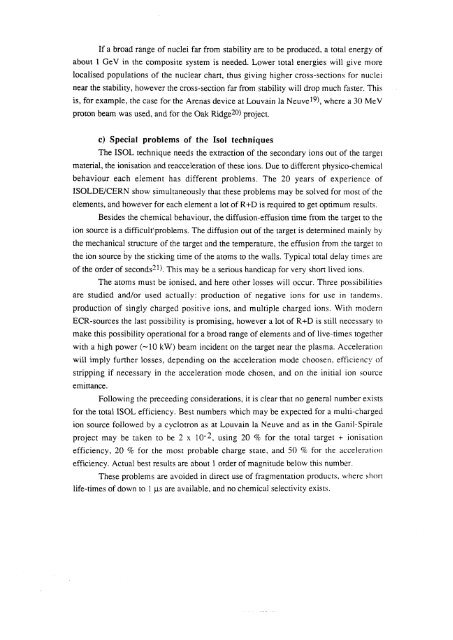Radioactive beams by fragmentation and ISOL techniques - CERN
Radioactive beams by fragmentation and ISOL techniques - CERN
Radioactive beams by fragmentation and ISOL techniques - CERN
You also want an ePaper? Increase the reach of your titles
YUMPU automatically turns print PDFs into web optimized ePapers that Google loves.
emittance.<br />
If a broad range of nuclei far from stability are to be produced, a total energy of<br />
about l GeV in the composite system is needed. Lower total energies will give more<br />
localised populations of the nuclear chart, thus giving higher cross—sections for nuclei<br />
near the stability, however the cross-section far from stability will drop much faster. This<br />
is, for example, the case for the Arenas device at Louvain la Neuvel9), where a 30 MeV<br />
proton beam was used, <strong>and</strong> for the Oak Ridgem) project.<br />
c) Special problems of the Isol <strong>techniques</strong><br />
The <strong>ISOL</strong> technique needs the extraction of the secondary ions out of the target<br />
material, the ionisation <strong>and</strong> reacceleration of these ions. Due to different physico-chemical<br />
behaviour each element has different problems. The 20 years of experience of<br />
<strong>ISOL</strong>DE/<strong>CERN</strong> show simultaneously that these problems may be solved for most of the<br />
elements, <strong>and</strong> however for each element a lot of R+D is required to get optimum results.<br />
Besides the chemical behaviour, the diffusion—effusion time from the target to the<br />
ion source is a difficultfproblems. The diffusion out of the target is determined mainly <strong>by</strong><br />
the mechanical structure of the target <strong>and</strong> the temperature, the effusion from the target to<br />
the ion source <strong>by</strong> the sticking time of the atoms to the walls. Typical total delay times are<br />
of the order of secondsm). This may be a serious h<strong>and</strong>icap for very short lived ions.<br />
The atoms must be ionised, <strong>and</strong> here other losses will occur. Three possibilities<br />
are studied <strong>and</strong>/or used actually: production of negative ions for use in t<strong>and</strong>ems.<br />
production of singly charged positive ions, <strong>and</strong> multiple charged ions. With modern<br />
ECR—sources the last possibility is promising, however a lot of R+D is still necessary to<br />
make this possibility operational for a broad range of elements <strong>and</strong> of live—times together<br />
with a high power (~lO kW) beam incident on the target near the plasma. Acceleration<br />
will imply further losses, depending on the acceleration mode choosen, efficiency of<br />
stripping if necessary in the acceleration mode chosen, <strong>and</strong> on the initial ion source<br />
Following the preceeding considerations, it is clear that no general num ber exists<br />
for the total <strong>ISOL</strong> efficiency. Best numbers which may be expected for a multi-charged<br />
ion source followed <strong>by</strong> a cyclotron as at Louvain la Neuve <strong>and</strong> as in the Ganil—Spirale<br />
project may be taken to be 2 x 10%, using 20 % for the total target + ionisation<br />
efficiency, 20 % for the most probable charge state, <strong>and</strong> 50 % for the acceleration<br />
efficiency. Actual best results are about l order of magnitude below this number.<br />
These problems are avoided in direct use of <strong>fragmentation</strong> products. where short<br />
life-times of down to l tts are available, <strong>and</strong> no chemical selectivity exists. OCR Output















